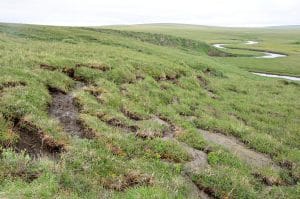As Arctic tundra has warmed more than twice as fast as the rest of the planet in recent decades, scientists are concerned about how the Earth’s rising temperature is affecting changes at high latitudes that impact greenhouse gases in the atmosphere. However, measuring changes in vegetation productivity across the Arctic—so-called “greening” and “browning”—has proven challenging because of mismatches between field measurements and satellite observations.
“Much of our understanding about landscape-scale changes has come from a series of meteorological satellites that indicate the Arctic is greening, but those satellites weren’t designed for vegetation monitoring and it’s been difficult to link them to what’s happening on the ground,” said Scott Goetz, a professor in the School of Informatics, Computing, and Cyber Systems (SICCS) at Northern Arizona University and science lead of NASA’s Arctic Boreal Vulnerability Experiment (ABoVE), which has some 730 science team members.
Currently, Goetz and Logan Berner, an assistant research professor in SICCS, are involved in an effort that brings together remote sensing scientists and field ecologists to provide a better understanding of how vegetation is changing throughout the Arctic. Previous studies have reached different conclusions about recent changes in Arctic vegetation productivity, which at least partially offset greenhouse gas emissions from permafrost thaw and fire disturbance. As a result of this work, Goetz and Berner co-authored an article published this week in Nature Climate Change entitled “Complexity revealed in the greening of the Arctic.”
The publication involves 40 co-authors from diverse scientific institutions around the world, including the School of Geosciences at the University of Edinburgh, the School of Geography and the Environment at the University of Oxford and the Department of Evolutionary Biology and Environmental Studies at the University of Zurich, among others.

“Vegetation productivity is important because it is one of three components of the Arctic system that determine the balance of terrestrial carbon exchange with the atmosphere,” said Goetz. “The other two are respiration from microbes in the soil as they break down organic matter, which has increased with the thawing of permafrost soils, and wildfire, which rapidly releases tremendous amounts of carbon through the burning of vegetation and soil organic matter.”
Satellite records indicate widespread greening trends across the circumpolar Arctic, but the new paper lays out a research framework to better characterize how changes vary across space and time and among various satellite data sets, as well as how the changes are interpreted and integrated with field measurements.
“There are a number of challenges to inferring decadal-scale trends in vegetation productivity across the Arctic,” Berner said. “We’ve relied on National Oceanic and Atmospheric Administration (NOAA) satellites in recent decades, but now other satellite data are increasingly available that enable us to better resolve changes. We’re confident the Arctic is greening, but we want to do a better job incorporating new satellite and drone remote sensing data with field measurements to understand where, why and how vegetation is changing across the Arctic domain.”
Greening indicates systematic increases in the growth of vegetation, which takes up carbon from the atmosphere. However, the researchers also hope to further their understanding of browning events, which indicate declining productivity and have been linked to extreme temperature changes, drought and fire disturbance.
“Wildfires in many regions have increased in extent and severity with warming, and there is a growing recognition that fires also will become more frequent and severe in tundra ecosystems,” Goetz said.
Changing vegetation productivity in the Arctic also is important because it influences how wildlife like caribou and moose will persist in the world’s largest wild areas and how the human communities that depend on them for subsistence will be affected.
“The aim of this research is ultimately to understand how satellites can provide better information on how much carbon is being removed from the atmosphere by Arctic vegetation relative to how much carbon is being released through permafrost thawing and fire. What is mitigating additional warming and what is exacerbating additional warming?” Goetz said. “We are charting a path forward to improve and advance the research.”
The paper arose from a tundra vegetation dynamics working group supported by the Synthesis Centre of the German Centre for Integrative Biodiversity Research and also was informed by a U.S. National Academy of Sciences workshop that Goetz chaired, entitled “Understanding Northern Latitude Vegetation Greening and Browning.” Berner and professor Michelle Mack of NAU’s Center for Ecosystem Science and Society were among the presenters. Their participation was supported by the NASA ABoVE program.
Bonnie Stevens | Office of the Vice President for Research




